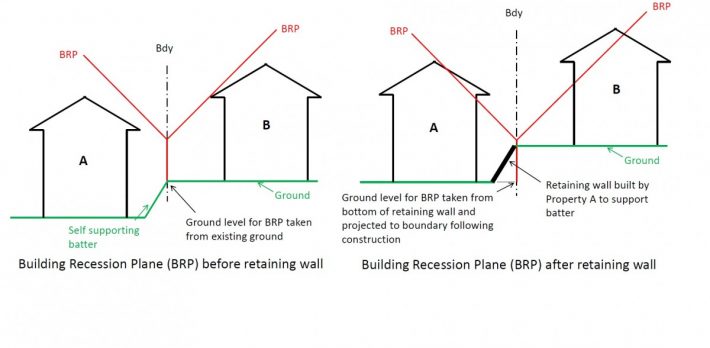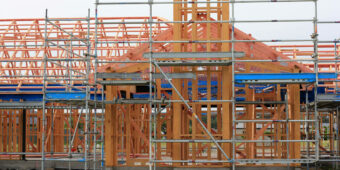WCC faces district plan change
22 Sep 2017, Industry News, Regulation

A brouhaha between Wellington neighbours that boiled over into the Environment Court has serious implications for the city’s builders, developers and homeowners dealing with sloped sites – which is a large majority!
The trouble began in 2015 when David Walmsley built a ‘play structure’ on the back of his family’s Roseneath property that severely affected the views of his uphill neighbours, Peter and Sylvia Aitchison.
Several court appearances later, the Environment Court ordered that the structure be removed and ruled that Wellington City Council (WCC) had wrongly interpreted its own district plan in allowing it to be built in the first place.*
The relevant section of the plan related to building recession planes and structures, particularly retaining walls, built on boundaries. To determine what space a property owner can legally build in without requiring a resource consent, the WCC district plan allows for the creation of a building envelope.
This envelope is determined by measuring vertically 2.5m from a boundary, with an inclined plane extended from the top point at an angle of 45-71° depending on the areas zoning.
WCC Resource Consents Team Leader Bill Stevens says that the Environment Court’s ruling has changed the way the vertical measurement is taken when a retaining wall is located on a boundary.
“Previously, the measurement was taken from the surface of the retaining wall where it was intersected by the boundary. This could be either at the top or on the face of the wall,” said
Stevens. “Following the Environment Court decision, it now has to be taken from the bottom of the wall in all cases, even if it just touches the boundary within the legal tolerance. This could massively affect people’s building rights.
“Say you’re on a sloping section and your neighbour excavates 3m on your boundary to build a courtyard and puts up a retaining wall, effectively they’ve inadvertently taken 3m off your building rights and could also significantly affect their own.”
Stevens said the absurdity of the ruling is highlighted by the fact that if the excavation was a self-supporting cut, then the measurement would be taken as usual from top of the face.
“This has all come about because of a poorly conceived structure that had a significant impact on a neighbour. Also, there was actually no need to compromise the way the district plan was being applied because there was already a process available to deal with unreasonable structures, regardless of whether or not it complies.”
In the case of existing houses with retaining walls, he says that parts of the structure may now be considered noncompliant, which could cause difficulties down the line if someone wanted to renovate their home.

This diagram illustrates how the Environment Court ruling could affect Wellington property owners’ building envelopes
Where someone constructed a new retaining wall that pushed parts of an existing structure outside of its building envelope, Mr Stevens said the owners of the affected property would not be forced to obtain a resource consent under the new interpretation.
He did warn that any future work on the affected property that previously wouldn’t have required a resource consent may now require one as a result.
After unsuccessfully appealing the ruling in the High Court, Stevens said the council is now faced with the question of whether or not it needs to change the district plan.
Mike Fox, director of Wellington building firm Primesite Homes, said that the Environment Court’s decision makes little sense.
“In my experience, it is rare to see a legal answer to a technical building problem that makes practical sense,” said Fox. “This is a prime example of this, and it has left everyone scrambling to make sense of it and the huge impact it will have on homeowner’s property rights.”
Fox anticipates it will affect his business by imposing uncertainty, delays and extra cost on projects.
He also believes less building and more cancelled projects will be an outcome of the decision.
“The greatest effect will be on homeowners who have purchased land or are planning a new home based on one assumption, only to find now that the home they thought could be built can’t be,” he said. “It will impact on the value of the land and, in some cases, might make what was a usable section unbuildable. In these times of land shortages, a decision like this is most unhelpful and goes against long-held interpretations and practices.
“My advice to affected homeowners and builders would be do your homework and see if you can work around the interpretation of the current ruling. By moving a wall a small amount, it could either work to your advantage or seriously against you.”
He added that people looking to purchase a property would be required to do more due diligence, especially if there are existing retaining walls in place, and cautioned people to be wary if someone builds beside their section.
“If they excavate to the boundary and put a wall in, then your new height control plane gets taken from the bottom of the wall, which seriously impedes your building envelope. You have no control over a very important aspect of your building envelope. How crazy is that?”
*The WCC was still considering its options at time of print, and no decision to change (or not change) the district plan has yet been made.
Register to earn LBP Points Sign in



